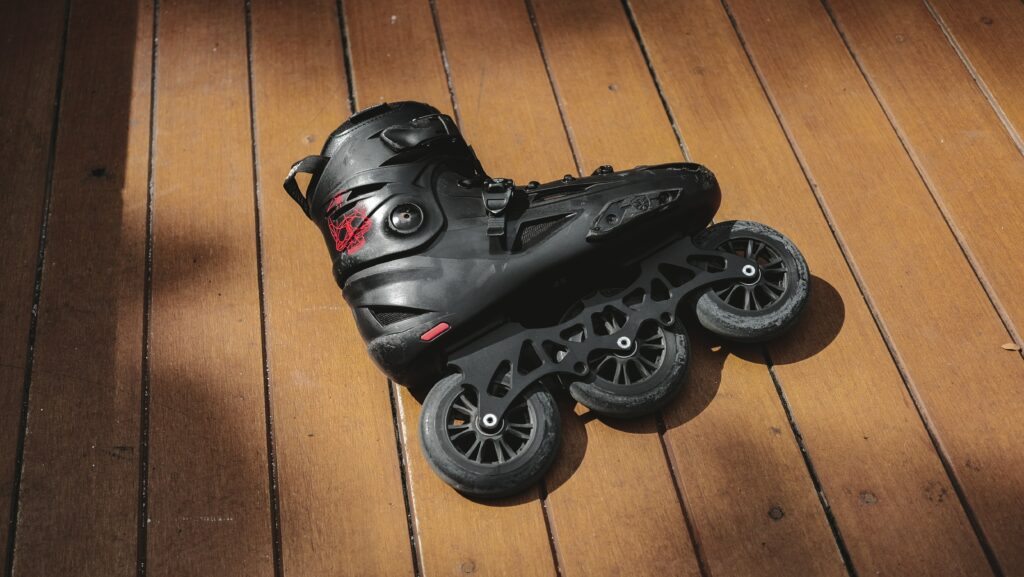by Trevor Miyamoto

To get the highest performance and the most enjoyment out of your skates and gear, all you need do is complete a few maintenance procedures. Just before or right after each outing, take five to ten minutes to rotate your wheels, wipe down your bearings, check your spacers and inspect your brake system components. Making these simple maintenance procedures a part of your skating routine will also help to ensure you have a safe and enjoyable skating experience each time you head out.
WHEELS

After you skate a few times you will notice that your wheels will be wearing more to one side (usually inside of foot). Just like a car, the wheels on your skates must be periodically rotated to even out the wear and maximize their usable life. Wheel wear is affected by many different factors including: skating surface, frequency and length of outings, skaters weight, skating style and activity, temperature, wheel size and shape, urethane quality, etc. For this reason, your wheels may need rotation as often as every day or once a week. A good rule of thumb is “every time you skate”. Consult the owners manual in your skate box for specific wheel rotation instructions.
BEARINGS
Bearings need to be kept clean to maintain their top performance. Your bearings probably won’t require complete cleaning every time you rotate your wheels, but if they become wet it is advisable to remove both (two) bearings and the bearing spacer from each wheel and wipe them dry/clean. Never lubricate the outside of a bearing as it will only attract contaminants.
Bearings are either serviceable or non-serviceable. Serviceable bearings have a metal shield with a removable “C” ring, or have a plastic/rubber style removable shield. Bearings with removable shields may be opened/disassembled and serviced. Servicing involves using a solvent to remove the old lubricant and accumulated contamination, rinsing and drying the parts, and re-lubricating and reassembling the bearings. Non-serviceable bearings that have a metal shield which are staked/crimped metal edges (folded/pressed under the outer ring). These need only be wiped off with a clean, dry cloth. Consult your owners manual in the skate box or call the company you purchased your bearings from for specific instructions.
BRAKES
Check the wear on your brake pad before and after every time you go out. Make sure the brake is firmly attached; if your skate employs advanced brake technology (such as cuff-activated or disc brakes) make sure all brake components are functional. Brake pads have a “wear line” which indicates how much life is left in the brake. It’s critical to replace your brake pad BEFORE this wear line is reached. Adjust the position of the brake so it does not interfere with normal skating.
UPGRADES
Eventually the rolling components (wheels, bearings, hardware) will wear out and need replacement. This is a great opportunity to select a different set of wheels and/or bearings with the design characteristics that can fulfill the performance needs (speed, maneuverability, handling) of your preferred inline activity. When selecting a wheel some things to consider are: diameter (size), durometer (hardness) and profile (shape). When selecting a bearing the most important factors to consider are: Serviceability, ABEC Rating (precision), Lubrication (speed/maintenance/protection), Materials (rings/retainers/shields), Internal Geometry (shallow vs. deep groove).
CUSTOM FITTING
Because every foot is a little different, some people may encounter fit related problems (blisters, foot moves inside skate, chaffing, etc.) causing discomfort or performance issues. These can usually be corrected by using additional fit pads or inserts. Check with your local skate or ski shop to find an experienced custom boot fitter.
REPAIRS
Most items on your skates can be repaired or replaced. Even things like buckles, liners and frames. Check with your local inline skate dealer or call your skate manufacturer for a dealer in your area that performs repairs.
PROTECTIVE GEAR/LINERS
Most protective gear and skate liners can be washed. The recommended method is usually hand washing in a mild detergent and air drying. Check with your specific skate manufacturer for care/washing instructions on your specific skate model.
Anson
My name is Anson Nakamura and I have been inline skating for fun for 18 years. My friends and I skate at our local skate park and we just love to skate. I have been a big fan of the sport since I was a little kid. I started with a pair of Rollerblades that I got from a garage sale. I was terrible at first, but I kept at it and eventually I got pretty good. Now, I can do all sorts of tricks and I love skating more than ever. There's nothing quite like the feeling of cruising around on your skates, wind in your hair. f you've never tried skating, I urge you to give it a go. It's an incredible feeling and you might just get hooked like I did.
